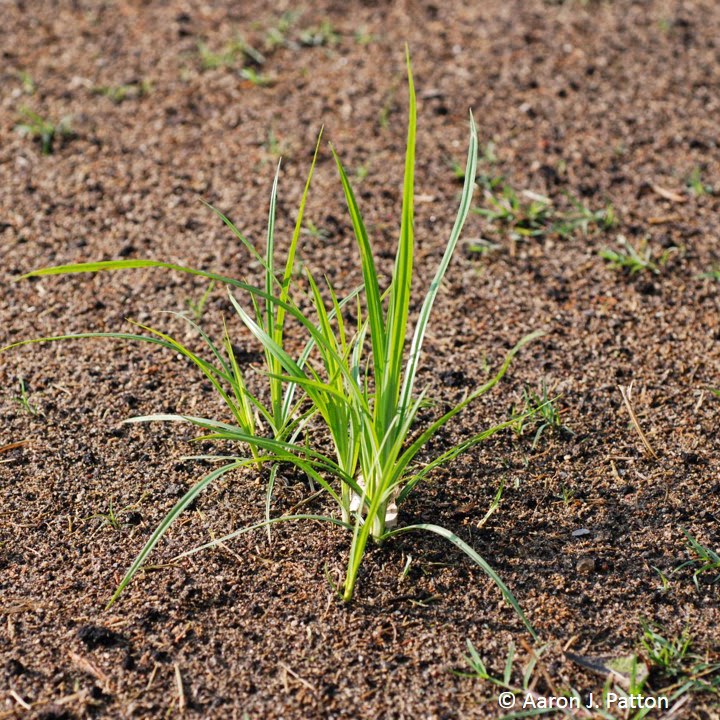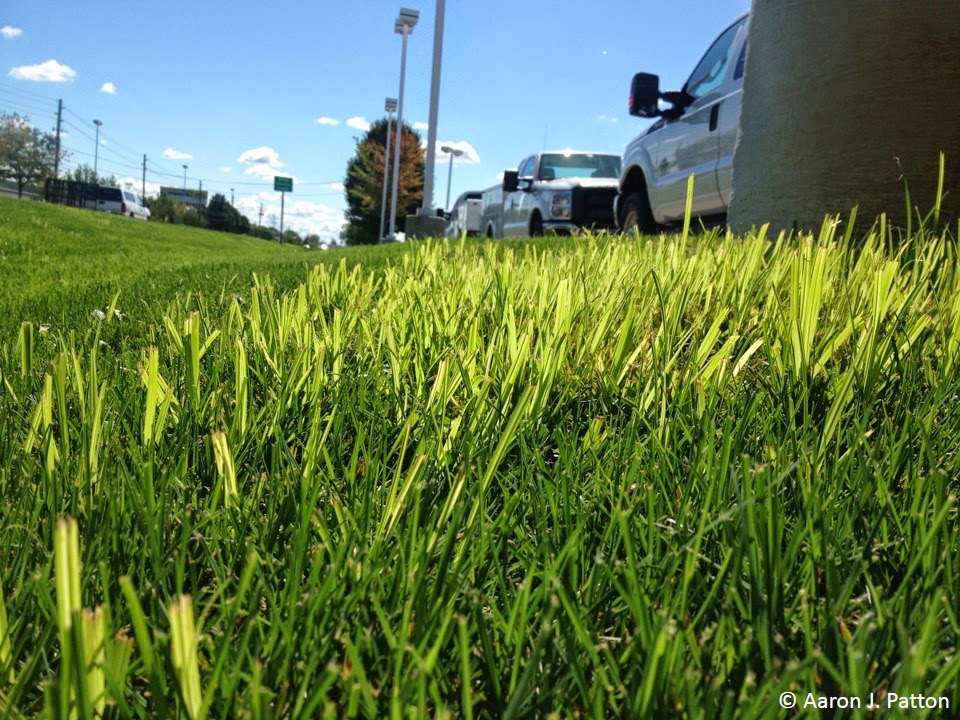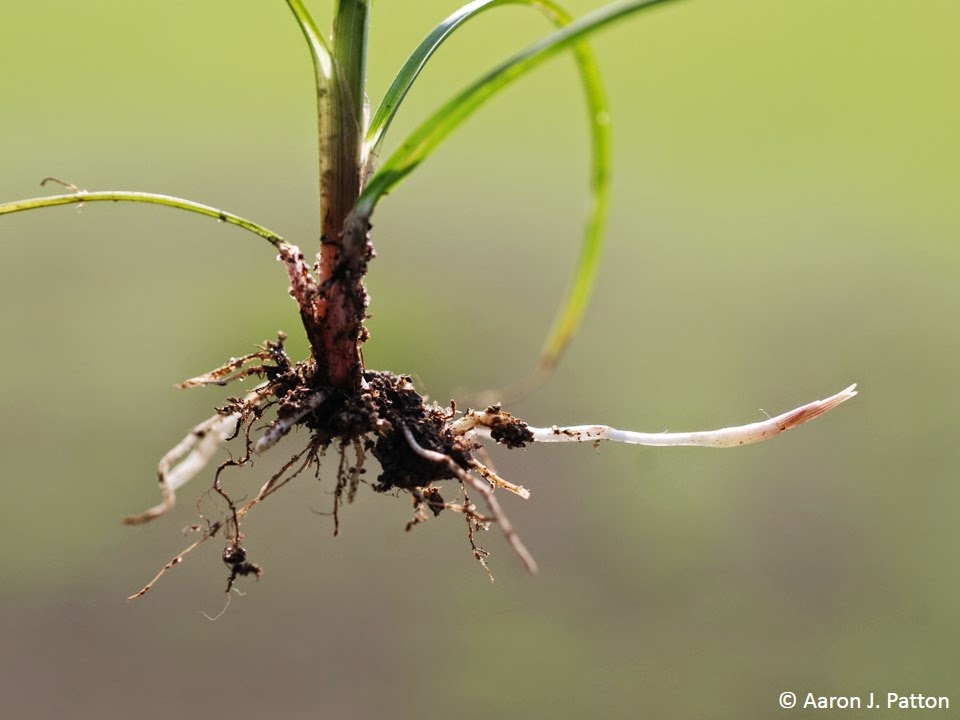Yellow Nutsedge
Biology: Yellow nutsedge (Cyperus esculentus), also known as chufa (chufa is a non-weedy variety that is used for wildlife food plots and is not a cold hardy weed like yellow nutsedge), nutgrass, or watergrass, is a troublesome, difficult-to-control perennial weed found throughout the United States. It is important to understand that yellow nutsedge is not a grass or a broadleaf weed, but a sedge; which is crucial when determining effective control strategies. It establishes by rhizomes, which form tubers (called nutlets) that are capable of surviving in the soil for periods of up to ten years. These nutlets, as well as viable seed, sprout and establish from May until the end of July. The ability of nutlets to survive long periods in the soil and the mature plant to withstand frequent, low mowing practices, make yellow nutsedge a difficult-to-control weed in turf.
Identification: Yellow nutsedge is most noticeable in the summer during periods of high temperatures and drought because its leaves grow more rapidly than the surrounding turf. Yellow nutsedge can be identified by solid, triangular-shaped stems which are be easily determined by rolling the stem back and forth between fingertips. Yellow nutsedge leaves have a prominent mid-rib and are arranged in threes which also help to distinguish it from grasses. Leaves are a light green to yellowish in color, have a shiny/waxy appearance, and have a long leaf-tip tapered to a sharp point. While many grasses have hairs on the leaf blades, such as crabgrass or bermudagrass, yellow nutsedge leaves and stems are completely smooth, which accentuates the shininess of the leaves. Though it seldom forms in areas of mowed turf, yellow nutsedge produces golden to brown colored seedheads (short spikelets) from July to September. It is often mistaken for purple nutsedge; however, purple nutsedge has dark green leaves that quickly taper to a blunter tip, and produces reddish brown to purple seedheads (spikelets). Additionally, purple nutsedge develops tubers along the entire length of rhizomes where yellow nutsedge only produces tubers at rhizome tips.
 |
| |
 |
| Yellow nutsedge grows more quickly than the surrounding cool-season turf during high temperatures |
 |
| Purple nutsedge (left) leaf tip compared to yellow nutsedge (right) leaf tip |
 |
| Growth habit is a 3-leaf arrangement |
 |
| Cross-cut shows solid triangle-shaped stem |
 |
| Establishes by rhizomes beneath the soil surface |
 |
| Nutlets formed (top) and forming (bottom). Photo credit, Corey Gerber. |
 |
| Light golden/brown seedhead |
 |
| Yellow nutsedge leaves have a distinct waxy/shiny appearance in cool-season turf |
 |
| Presence can indicate poorly-drained or compacted areas where surrounding turf struggles |
 |
| More problematic on turf that is mowed to short or in areas of poor drainage such as low areas in the golf course fairways (above). |
Cultural control: The best method of cultural control is a dense, aggressive turf that can successfully outcompete invading weeds for nutrients and space. Yellow nutsedge is more problematic on turf that is mown too short and thrives in areas where the soil is constantly moist from over-watering or poor irrigation drainage. Cultural practices such as increasing mowing height, watering deeply and infrequently, and cultivation (aeration) to alleviate soil compaction may help to maintain yellow nutsedge. If populations are small enough, hand-pulling will help to remove the above-ground-tissue; however, within a few weeks the plant will most likely grow back from the underground tubers. When yellow nutsedge is located in a landscape system, it is best to try and dig-out the entire plant (including the root/rhizome underground system) for more prolonged eradication.
Biological control: None known for specific use in yellow nutsedge.
Chemical control: Yellow nutsedge is a difficult-to-control weed that may require multiple herbicide applications. Purdue extension offers many publications about establishing, maintaining, and controlling lawn pests such as weeds. This information is available at The Purdue Extension Education Store or The Purdue Turf Program website. For yellow nutsedge herbicide control options for homeowners refer to publication
AY-19-W, and for turf professionals refer to publication
AY-338-W. Both publications are free for electronic download.
Aaron Patton, Turfgrass Extension Specialist
Leslie Beck, Postdoctoral Research Associate

